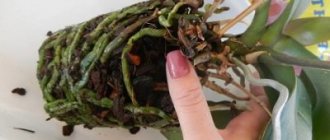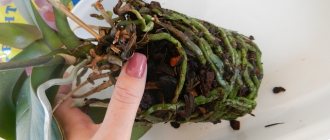The beautiful and delicate orchid gradually stops flowering, and the pot becomes noticeably cramped for it. To prevent problems with growing and wait for future flowering, you need to know how to replant an orchid at home. The editors of Agronom.guru will tell you in the article what pitfalls can await you during transplantation.
With proper care, the plant will delight you with beautiful flowering
Why you need to replant orchids - the main reasons
The recommended schedule for replanting phalaenopsis into a new container or other substrate is every 2-3 years. This is due to the stress the plant experiences during this process.
Any variety of orchid needs timely replanting
The urgent need for a new pot or soil is due to the following factors:
- soil depletion;
- disturbance of the balance of mineral substances in the substrate;
- change in acidity level;
- loss of breathability;
- soil compaction does not allow the root system to develop optimally and even causes root rot;
- replanting after 3 years is necessary if the main component in the substrate was bark. If it was sphagnum moss, then the soil needs to be replaced within 2 years after planting.
A cramped pot, from which roots stick out in all directions, needs to be replaced with a more spacious one.
If the pot has become cramped, the roots will begin to push the soil out of the container, which will undoubtedly affect the health of the flower.
Is it possible to replant a blooming orchid?
An emergency transplant during flowering can be done for a number of reasons: an army of pests has appeared on neighboring plants, you notice signs of rotting or other diseases. An orchid is also replanted after purchase, even during flowering, if it is obvious that the flower does not feel well in this soil. We will tell you how to do this below.
Sometimes you have to make a choice: a long life of a plant with delayed flowering or short days in bloom and the death of the orchid. If you want to see your plant healthy and pleasing to the eye for many years, then do not ask whether it is possible to replant the plant during flowering. It’s better to cut off the peduncle and replant the beauty.
Do I need to replant my Orchid after purchasing it?
People, when purchasing this plant for the first time, want to transplant it into a more beautiful pot so that it looks more beautiful in the interior of the house. Here the answer to the question of whether it is necessary to replant an orchid from a store pot will not be unambiguous.
It is worth remembering that the best time for replanting is still spring, and therefore you need to take a better look at what the plant’s root system looks like through a transparent pot. If there are no black or dry parts on it, and the soil is not covered with mold, the flower is left until spring. Since the best time is the beginning of April . It becomes warmer, the day lengthens, there will be a lot of diffused sunlight and fresh air in the room.
If the root system does not cause concern, then replanting is postponed until spring.
But if the plant remains in purchased peat, do not forget that it is moisture-intensive and dries out slowly, so you need to water the flower once a month in winter, and once a week in summer . And make sure that excess moisture does not accumulate in the pan.
IMPORTANT! If the flower feels comfortable in the purchased soil and its root system develops, it should be left until spring so as not to injure it again.
Signs that the procedure is necessary
- darkened roots - this sign indicates that not everything is fine with the root system of the flower and most of the roots have died. Therefore, replanting is carried out with a complete replacement of the soil and removal of rotten parts of the root system. After the dead roots are cut off, the cut area must be sprinkled with cinnamon or crushed coal;
- the flower sways in the pot - this means that most of the roots have died and the flower needs to grow a new root system;
- pseudobulb base color – a healthy shade of pseudobulb base is green. Or if it is under the ground, it is yellowish. If the color is brown or black, then the flower needs to be re-rooted;
- It is worth removing sphagnum from the roots - this is an obligatory part of the procedure that is performed during transplantation. Moss is necessary when growing roots in a child; later it can cause rotting of the base of the orchid rosette;
- a stop in development - this occurs because the roots no longer have access to the nutrition that it consumes when extracted from the soil. Simply put, there are a lot of roots, but practically no soil, and the flower needs to purchase a large container and replant it.
An orchid is a rather delicate flower that requires constant attention and care. But everything will pay off when the second flowering begins, which will come only thanks to the grower.
If she looks healthy?
The purchased plant is carefully inspected for mechanical damage and various pests. If it looks quite healthy, then a planned replanting can be carried out , which will coincide in time with the end of flowering (but not in winter) or in March-April, when spring contributes to better growth of the orchid’s root mass.
A healthy orchid is replanted after flowering has ended.
Possible harm
This procedure is harmless, since after the flower is at home, factors may be discovered that will require an urgent transplant, otherwise the flower will die . A completely healthy flower is quarantined for a couple of weeks and only after that is transferred to a permanent place with other house plants.
Accustoming the root system to the substrate
For some time after transplantation, the orchid's root system gets used to the new habitat. At this time some of the old roots may die ; this can be easily determined by their color, since when they die, they become empty and acquire a brown tint.
There is no need to replant so as not to destroy the flower. Young green roots should grow in place of old rhizomes.
What kind of pot is needed for an orchid - capacity requirements
A pot for orchids must be transparent. This condition is necessary in order to observe the development of roots and monitor the condition of the soil. If desired, transparent containers are placed in a pot that is pleasing to the eye. We recommend choosing a larger pot. It will be enough if the new container is several centimeters wider than the previous one.
Before replanting, the new container is disinfected, and then only a layer of drainage is laid out.
Caring for a plant when it blooms
Most orchid species enter a short resting phase after flowering. Its restoration and preparation for the next flowering depends on proper care of the plant at this time.
Proper watering
During the dormant period, the plant's need for moisture is reduced, so watering is reduced. The frequency and intensity of substrate moistening depends on the type of plant:
- varieties with fleshy pseudobulbs (Cattleyas, Oncidiums), which store moisture and nutrients, can rot if overwatered;
- species without bulbs (Phalaenopsis, Vanda) are not able to accumulate moisture, so they continue to be watered almost as during flowering, focusing on the condition of the substrate.
Attention! During the dormant period, the plants are not sprayed.
Pruning branches
Old stems require pruning in sympodial orchids. These include Dendrobium, Cattleya, Lelia. This variety has several growing points and is a bush. After flowering, the leaves on the pseudobulbs die off and the orchids lose their decorative properties.
Attention! The bulbous stems can be cut off as they no longer produce flowers. But the procedure should be started only after the leaves have dried. Until this time, the pseudobulbs release accumulated nutrients to the plant.
The branches are cut with a sharp, pre-disinfected sharp knife at the very base. Wounds are treated with ground charcoal or cinnamon.
Fertilizer
There is no consensus on feeding orchids after flowering. Fertilizer manufacturers offer formulations for fertilizing at different stages of plant development and claim that you should not stop adding nutrients even during the dormant period.
However, experts and experienced gardeners argue that continuous application of fertilizers causes active growth of green mass and limits the formation of buds. The famous biologist and landscaper M. Ivanov advises monitoring the condition of the plant:
- If a new bulb grows, you can add a little nitrogen-containing fertilizer.
- If there are slight signs of the formation of a flower arrow, apply phosphorus-potassium fertilizer.
- When there are no signs of vegetation, fertilizers should not be applied.
How to choose a substrate and what kind of soil is needed for orchids
The beautiful orchid needs a loose substrate. It is preferable to purchase a ready-made mixture in a store. If you undertake to prepare the soil yourself, then take expanded clay for drainage, sphagnum moss or crushed conifer bark and charcoal.
The substrate should not only provide the flower with nutrition and oxygen, but also help secure the plant in the pot
After a couple of years, you will notice that the coal and bark have turned into dust, the soil has become dense and settled - it’s time to replant. To help you appreciate the benefits of breathable soil, we offer an introductory video on how to replant an orchid at home:
Signs that indicate the need for an urgent transplant
The main signs that a plant needs urgent replanting:
- This is acidified and compressed soil , which by the time the flower is sold becomes too dense and does not allow the root system to be saturated with oxygen;
- The transport soil is too moisture-intensive and it is difficult for an inexperienced gardener to adapt to it, and for this reason the orchid floods and it dies from excess moisture;
- Quite often, at points of sale, too much watering and for this reason the roots of the plant can be damaged - this requires a complete replantation plus a careful inspection of the horse system itself for the presence of rotten places;
- The flower itself at home needs normal specialized soil in which it can grow and develop;
- Wilting leaveswhich occurs due to improperly selected soil;
Leaves may wilt due to improper substrate.
- Stunting or dropping of unopened buds;
- When the soil stops functioning properly and it is constantly wet, even without watering.
IMPORTANT! If the purchased plant has at least one of these signs, you should immediately begin replanting the plant, which should be done according to all the rules.
When to replant an orchid immediately
If you notice that the soil has become dense, all the large components are more like dust, the orchid has become a refuge for aphids, thrips, scale insects and other “cute” guests, then it won’t be long until the plant dies completely. Sometimes you can notice rotting of the roots, or the green mass of leaves has become much larger than the size of the pot, which means you need to urgently replant the orchid, and we will tell you how to do this correctly at home.
If your orchid has just arrived at its new location from the store and looks completely healthy, replanting is not required. But when your ward looks unwell after purchase, it is better to start replanting it immediately.
How to get rid of midges in indoor flowers using simple methods. In a special publication on our portal, we will talk in detail about how to get rid of pests in indoor plants. You will learn the reasons for their appearance, the types of midges and their signs and measures to prevent the appearance of midges.
Preparing for orchid transplantation
The more responsibly you approach the transplant, the more successful the process itself will be. Before you get started, prepare everything you need: disinfected scissors or a sharp knife for cutting faded peduncles, a new transparent pot, fresh loose substrate, an activated carbon tablet.
If the orchid has just finished delighting you with its flowering, then the peduncle needs to be cut off. After this, you can begin the process of replanting the plant.
How to replant an orchid at home step by step
To make the process of transplanting an orchid at home easy, we suggest studying all the key points step by step.
We remove the flower from the previous pot. The more careful the better. The root system must remain intact
For trouble-free removal, it is recommended to knead the pot with your hands.
If the soil or pot is too dense and the plant does not give in, then it is better to sacrifice the container rather than the flower and cut it with scissors. Since the process can be messy, we recommend laying out a large newspaper or heading to the bathroom.
It is generally preferable to remove a plant from a pot under running water, so the roots can be removed painlessly and immediately inspected for pests or rot
Now we will tell you how to properly plant an orchid in a pot. Expanded clay is placed in a new container and lightly sprinkled with substrate. Then you need to carefully plant the orchid, spreading the roots evenly. Hold the plant by the root collar. The remaining space is filled with substrate, the pot is tapped and the plant is watered.
The upper aerial roots should not be forced into the pot; leave them on the surface of the soil.
When examining the roots during transplantation, rotting processes or parasites can be detected. Diseased parts of the roots are cut off and thrown away, the sections are treated with Kornevin and sprinkled with charcoal. The same applies to dried roots. If you notice pests, the plant must be placed in a container with warm, clean water for 2-3 hours, and then treated with a suitable insecticide.
Planting into new soil after washing the roots is carried out only after the root system has completely dried
The lower yellowed leaves of the plant are also removed.
Now you know how to painlessly transplant an orchid into another pot
Tips and tricks
Some tips will help you replant your orchid so that it continues to delight you with its flowering. So, after washing the roots from the old soil, they need to be dried for a long time, about 7 hours. Drainage can be not only expanded clay, but, for example, broken brick, but only crushed, and even pebbles.
If the orchid has already grown greatly, then it should be divided into two pots. After transplantation, such a plant should be cared for more carefully and thoroughly. It is always worth remembering that any transplant for an orchid is a lot of stress, so you should be careful and competent about this procedure.
If gardeners were wondering whether it is possible to replant an orchid when it is blooming, now they no longer face such a question.
Caring for an orchid after transplantation
The period after transplantation is called recovery for a reason. Any major intervention in the life of a plant creates stress for it. So, a few rules on what to do after transplantation:
- the pot is placed in a shaded place, closer to the eastern window;
- air temperature is maintained within +21°C;
- watering after transplantation is done after 5 days;
- leaves can be sprayed daily with warm water;
- after a month they begin to apply fertilizers.
Simple care techniques will allow this beautiful flower to quickly gain strength.
Replanting after flowering
The orchid's rest period after flowering is the best time to replant it. This procedure is very responsible, and when carrying it out, it is necessary to take into account the recommendations of experienced flower growers.
How often?
On average, replanting into a new pot and replacing the soil is carried out once every 2-3 years, focusing on the condition of the root system. However, in some cases an emergency procedure is required:
- the roots protrude strongly above the surface of the pot;
- the substrate has crumbled or a white coating appears on its surface;
- rotting of the roots is observed.
Preparing the pot and substrate
When selecting a container for replanting an orchid, it is worth taking into account the peculiarities of its root system. For species with a photosynthetic system, the pot must be transparent: only in this case will the plant receive the necessary amount of sunlight for normal life.
Regardless of the type of plant, the dishes must provide high-quality water flow and air access to the roots. Holes are located in the bottom and along the walls of the pot. Active aeration will allow the roots to receive additional nutrition from the air and prevent the formation of rot.
The diameter of the pots is determined based on the size of the root system. It should be freely and completely immersed inside, but without creating excess space. In a container that is too large, the plant will not be stable, and the substrate will become salty.
Advice! A good choice for planting orchids is wicker or clay pots. They provide comfort for the roots and at the same time have a presentable appearance and fit well into any interior.
Orchids also have special requirements for the growing substrate. It must be nutritious, air and water permeable. The ideally selected composition compacts well, dries in 3-4 days, but at the same time retains the amount of moisture necessary for the roots.
A simple solution is to use a ready-made mixture from the store. There must be a note on the packaging stating that this is a substrate for epiphytes. The presence of earth is not allowed in the mixture. The substrate for orchids contains only charcoal, oak or pine bark, fern roots, perlite, and coconut fiber.
You can make your own substrate using one of the following recipes:
- charcoal, pine bark, sphagnum moss – 1:5:0.5;
- charcoal, moss, pine chips – 1:2:5;
- for some types of orchids - coal, high peat, pine bark, humus - 1: 1: 1: 3.
Important! Before grinding and adding to the mixture, the bark is cleaned of resin and dirt, then disinfected in a water bath for 30 minutes.
Transplant algorithm with photo
The orchid transplant procedure is carried out with the utmost care so as not to damage the roots:
- 2-3 days before replanting, stop watering the plant. On the day of transplantation, the substrate is well moistened.
- The orchid is carefully removed from the pot without any effort. If the plant does not yield, the pot is cut.
- The roots are immersed in warm water for 2-3 minutes, then the substrate is removed from them.
- The root system is inspected, rotten and dried parts are cut off. The cut areas are treated with charcoal.
- A layer of drainage is placed at the bottom of the pot at 1⁄4 height. Then pour in a little prepared substrate.
- Place the orchid in the pot and fill the space between the roots with the prepared mixture.
Important! The root collar is located above the surface layer of the substrate. Deepening will lead to rotting of the rosette and limit the growth of shoots.
What problems may arise after transplantation?
Let's consider possible problems that may appear after transplantation.
- If the leaves look lethargic, it means you are being greedy with watering: the substrate should not dry out completely. Another reason may be exposure to direct sunlight. Try putting the plant in the shade for a week.
- The plant does not bloom for a long time: if the establishment process is delayed, start feeding earlier.
The more carefully and accurately the transplantation process is completed, the less chance there will be problems after it.











